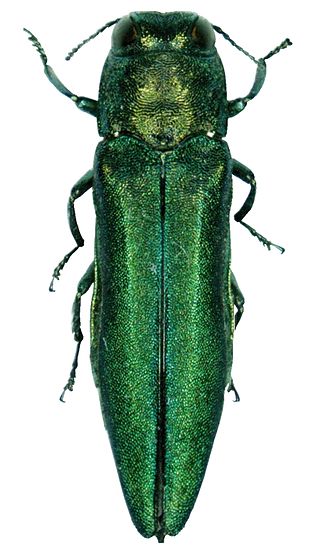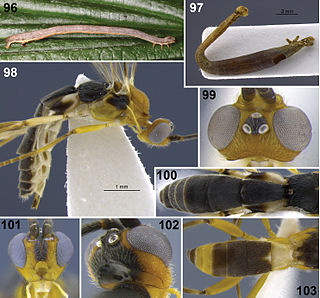
Fraxinus americana, the white ash or American ash, is a fast-growing species of ash tree native to eastern and central North America.

Icterids or New World blackbirds make up a family, the Icteridae, of small to medium-sized, often colorful, New World passerine birds. The family contains 108 species and is divided into 30 genera. Most species have black as a predominant plumage color, often enlivened by yellow, orange, or red. The species in the family vary widely in size, shape, behavior, and coloration. The name, meaning "jaundiced ones" comes from the Ancient Greek ikteros via the Latin ictericus. This group includes the New World blackbirds, New World orioles, the bobolink, meadowlarks, grackles, cowbirds, oropendolas, and caciques.

A midge is any small fly, including species in several families of non-mosquito Nematoceran Diptera. Midges are found on practically every land area outside permanently arid deserts and the frigid zones. Some midges, such as many Phlebotominae and Simuliidae, are vectors of various diseases. Many others play useful roles as prey for insectivores, such as various frogs and swallows. Others are important as detritivores, and form part of various nutrient cycles. The habits of midges vary greatly from species to species, though within any particular family, midges commonly have similar ecological roles.

The emerald ash borer, also known by the acronym EAB, is a green buprestid or jewel beetle native to north-eastern Asia that feeds on ash species. Females lay eggs in bark crevices on ash trees, and larvae feed underneath the bark of ash trees to emerge as adults in one to two years. In its native range, it is typically found at low densities and does not cause significant damage to trees native to the area. Outside its native range, it is an invasive species and is highly destructive to ash trees native to Europe and North America. Before it was found in North America, very little was known about emerald ash borer in its native range; this has resulted in much of the research on its biology being focused in North America. Local governments in North America are attempting to control it by monitoring its spread, diversifying tree species, and through the use of insecticides and biological control.

Agrilus anxius, the bronze birch borer, is a wood-boring buprestid beetle native to North America, more numerous in warmer parts of the continent and rare in the north. It is a serious pest on birch trees (Betula), frequently killing them. The river birch Betula nigra is the most resistant species, other American birches less so, while the European and Asian birches have no resistance to it at all and are effectively impossible to grow in the eastern United States as a result.

Anastrepha is the most diverse genus in the American tropics and subtropics. Currently, it comprises more than 300 described species, including nine major pest species, such as the Mexican fruit fly, the South American fruit fly, the West Indian fruit fly, the sapote fruit fly, the Caribbean fruit fly, the American guava fruit fly, and the pumpkin fruit fly, as well as the papaya fruit fly. As some of their names suggest, these pest species are one of the most numerous and damaging groups of insects in their native range, plaguing commercial fruits such as citrus, mango, guava, and papaya.

Agrilus viridis is a wood-boring beetle. It belongs to the jewel beetle family, Buprestidae.

Heliothinae is a small, cosmopolitan subfamily of moths in the family Noctuidae, with about 400 described species worldwide. It includes a number of economically significant agricultural pest species, such as Helicoverpa armigera and Helicoverpa zea.

Oobius agrili is a parasitic non-stinging wasp of family Encyrtidae which is native to North Asia. It is a parasitoid of the emerald ash borer, an invasive species which has destroyed tens of millions of ash trees in its introduced range in North America. As part of the campaign against the emerald ash borer (EAB), American scientists in conjunction with the Chinese Academy of Forestry searched since 2003 for its natural enemies in the wild leading to the discovery of several parasitoid wasps, including Oobius agrili, which is a solitary egg parasitoid of EAB found on ash trees in Jilin province in 2004; it has been recorded to kill up to 60 percent of EAB eggs.

Agrilus auroguttatus is a species of jewel beetle in the United States, known by the common name goldspotted oak borer. It is a woodboring beetle best known for destroying stands of oak trees in the Cleveland National Forest in San Diego County, California, in the United States. It was originally considered a subspecies of the Central American species Agrilus coxalis, and much of the literature refers to it by this name, but now it is regarded as a separate species, known only from Arizona and California.

Agrilus biguttatus is a species of beetle in the family Buprestidae, the jewel beetles. Common names include oak splendour beetle, oak buprestid beetle, and two-spotted oak borer. It is native to Europe, North Africa, and Siberia. This beetle is known as a pest that causes damage to oak trees and is a factor in oak decline.

Aleiodes is a genus of the family Braconidae of parasitoid wasps described by Constantin Wesmael in 1838. They are also known as mummy-wasps.
Agrilus mimosae is a species of metallic wood-boring beetle in the family Buprestidae. The distribution range of Agrilus mimosae includes Central America and North America.
Agrilus sayi, the bayberry agrilus, is a species of metallic wood-boring beetle in the family Buprestidae. It is found in North America.

Agrilus ruficollis, the red-necked cane borer, is a species of metallic wood-boring beetle in the family Buprestidae. It is found in Europe and Northern Asia and North America.
Agrilus otiosus, the hickory agrilus, is a species of metallic wood-boring beetle in the family Buprestidae. It is found in North America.
Agrilus bespencus is a species of metallic wood-boring beetle in the family Buprestidae. It is found in North America.
Agrilus granulatus, the granulate poplar borer, is a species of metallic wood-boring beetle in the family Buprestidae. It is found in North America.

Agrilus sinuatus, known generally as the sinuate peartree borer or hawthorn jewel beetle, is a species of metallic wood-boring beetle in the family Buprestidae. It is found in Europe and Northern Asia and North America.

Agrilus bilineatus, the two-lined chestnut borer, is a species of metallic wood-boring beetle in the family Buprestidae. It is native to North America, and has been introduced to Turkey.














